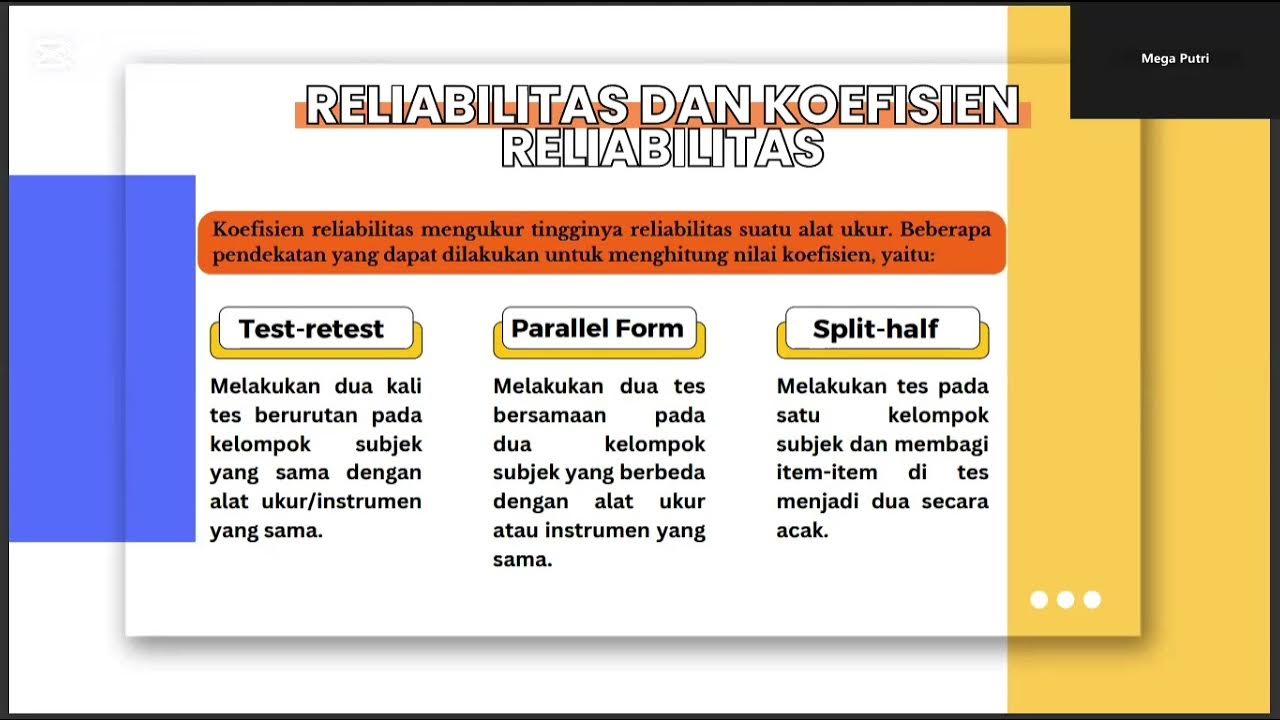Efek Heterogenitas Kelompok Pada Perubahan Reliabilitas dan Validitas Alat Tes
Summary
TLDRThis transcript explores how group heterogeneity impacts the validity and reliability of measurement instruments. It explains that by increasing the variability of a test sample, you can improve both the reliability and validity coefficients of the tool. Heterogeneous groups, with diverse characteristics, produce higher variance in results, enhancing the test's ability to differentiate between individuals. The lecture provides mathematical examples and practical advice on improving measurement tools through either increasing sample diversity or adding more items to the test, ensuring more accurate and consistent results in educational and psychological assessments.
Takeaways
- 😀 Heterogeneity in groups can significantly improve the reliability and validity of measurement tools by increasing variance in test scores.
- 😀 Increasing the sample size and ensuring a more diverse (heterogeneous) group can boost the reliability and validity coefficients of a test.
- 😀 Reliability and validity can be enhanced in two main ways: adding more items to the test or increasing the heterogeneity of the sample group.
- 😀 A heterogeneous sample, with varying characteristics (e.g., different IQ levels), produces greater variance, leading to higher reliability and validity coefficients.
- 😀 The formula for improving reliability with heterogeneity involves calculating the variance of the heterogeneous group relative to a homogeneous group.
- 😀 The higher the variance within a group (due to increased heterogeneity), the higher the reliability coefficient of the test.
- 😀 A more heterogeneous sample allows for a more accurate reflection of the population, leading to more dependable test results.
- 😀 Validity improvements also occur when testing on a more heterogeneous group, with the formula adjusting for variance differences between the groups.
- 😀 The formula for improving validity involves applying a square root function to the product of the variance of a heterogeneous group and the initial validity coefficient.
- 😀 Practical application: Increasing sample heterogeneity (e.g., more varied IQ scores, different backgrounds) or the number of test subjects can yield more reliable and valid measurement results.
Q & A
What is the main topic discussed in the video?
-The video focuses on the effect of group heterogeneity on the validity and reliability of measurement tools. It discusses how increasing heterogeneity in test samples can improve the reliability and validity coefficients of a test.
What are the two main methods to increase the validity and reliability of a test?
-The two methods discussed to improve validity and reliability are: 1) Adding more items to the test, and 2) Increasing the heterogeneity of the test group.
How does group heterogeneity affect the reliability and validity of a test?
-Group heterogeneity increases the variance in the distribution of scores. The higher the variance in a group, the higher the reliability and validity coefficients of the test, as it leads to a more diverse and comprehensive assessment of the test's effectiveness.
What is meant by group heterogeneity in the context of the video?
-Group heterogeneity refers to the diversity or variation within a test group, specifically the spread or variance of scores among individuals. A more heterogeneous group leads to higher variance and, consequently, higher reliability and validity for the test.
What is the effect of test sample size on heterogeneity?
-The size of the test sample can influence its heterogeneity. A larger sample size generally increases heterogeneity, but it also depends on the diversity within the group. If the sample includes individuals with a wide range of characteristics, it results in a more heterogeneous group.
How can test reliability be increased using group heterogeneity?
-Test reliability can be increased by conducting a second trial on a more heterogeneous sample. This increases the variance in the group's scores, which in turn improves the reliability coefficient of the test.
What is the formula for calculating test reliability after increasing group heterogeneity?
-The formula for calculating test reliability after increasing group heterogeneity is: r_x' = 1 - (variance of the homogeneous group / variance of the heterogeneous group) * (1 - r_x).
What is the significance of variance in the calculation of reliability and validity?
-Variance plays a crucial role in the calculation of both reliability and validity. A higher variance indicates a broader spread of scores within the group, which increases the likelihood that the test measures a wider range of abilities or traits, thus improving both reliability and validity.
How does changing the standard deviation (SD) affect test reliability?
-Changing the standard deviation, which is related to variance, affects the test's reliability. A larger standard deviation (more spread-out scores) in a heterogeneous group leads to higher reliability, while a smaller standard deviation (less spread-out scores) in a homogeneous group results in lower reliability.
In the example provided in the video, how does the increase in standard deviation from 3.4 to 7.5 affect the reliability coefficient?
-In the example, when the standard deviation increases from 3.4 to 7.5, the variance of the group also increases, leading to a higher reliability coefficient. The reliability increased from 0.73 to 0.945, demonstrating the significant effect of group heterogeneity on test reliability.
Outlines

This section is available to paid users only. Please upgrade to access this part.
Upgrade NowMindmap

This section is available to paid users only. Please upgrade to access this part.
Upgrade NowKeywords

This section is available to paid users only. Please upgrade to access this part.
Upgrade NowHighlights

This section is available to paid users only. Please upgrade to access this part.
Upgrade NowTranscripts

This section is available to paid users only. Please upgrade to access this part.
Upgrade NowBrowse More Related Video

ANALISIS DATA TAHAP AWAL

Pengantar Validitas Pengukuran

STATISTICS BASED ON SMARTPLS - ENGLISH FOR GENERAL PURPOSE (ANGELA VICTORIA - 2414190037)

Materi Validitas dan Reliabilitas || Part 1 || Statistika Penelitian || Pertemuan 4

Efek perubahan Panjang Tes Pada Reliabilitas dan Validitas Alat Tes

Teknik & Instrumen Pengambilan Data Kuantitatif
5.0 / 5 (0 votes)